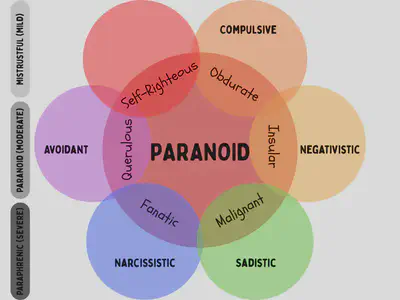Paranoid Personality Subtypes

Despite Paranoid Personality Disorder appearing in the first edition of the DSM in 1952 and staying until present day, there is a severe lack of research on it. Most of the research is focused on paranoid phenomena like psychosis and paranoia, but not the actual paranoid personality disorder.1 Interestingly, Millon advocated for paranoid personality disorder to actually be called vigilant personality disorder to differentiate if from other paranoia-related constructs.2 3 (For a better understanding of paranoid personality disorder, check out podcast episode 28: The Post-Pandemic Narcissist | Unmasking Paranoid Personality and its blog). Unlike narcissistic personality disorder and borderline personality disorder, paranoid personality disorder doesn’t really have much research or conceptualization of actual subtypes. Let’s look at the limited historical subtypes in the research and focus on the most recent subtypes of paranoid personality disorder by Millon.1 3
Historical Paranoid Personality Disorder Subtypes
From about the 1950s to the 1990s, aside from Millon 3 there’s only about four researchers who wrote about paranoid personality subtypes. All four wrote about a “weaker” and “stronger” subtype. The “weaker” subtype was labeled eccentric and sensitive, being more passive, secretive, constricted, cynical, and fantasy-focused. The “stronger” subtype was labeled combative and querelent, being more arrogant, openly defiant, bitter, argumentative, aggressive, and litigious.1 2 3 While somewhat helpful in understanding there are different “flavors” of paranoid personality disorder, Millon has contributed the most to this understanding.
Mistrustful Personality: Mild - Closer to “Normal” Level2 3
As with all of Millon’s personality subtypes, he groups them by severity, with mild subtypes being closer to “normal” and severe being closer to the psychotic/inpatient level (Check out this blog for more info). So let’s start with his less problematic subtypes of paranoid personality, which he labeled as Mistrustful (instead of Paranoid): The “Self-Righteous” subtype and the “Odurate” subtype.
Self-Righteous
The Self-Righteous Mistrustful subtype is functional to some degree, perhaps being a professor or business owner where control and self-sufficiency, paired with mistrust can be adaptive and protective. They are hypervigilant of any threat or attack, believing there is an enemy out there, but unsure of how close that enemy is, which means they can’t let their guard down. They come across as chilly, fearful, odd, humorless, rigid, and rule-bound.
Obdurate (Compulsive Features)
The Obdurate Mistrustful subtype overlaps with compulsive personality features, being self-righteous, stubborn, rigid, suspicious, and humorless. They try, and fail, to restrain their anger, so they end up projecting their hostility and actively rebelling against any outside constraints, so that they can feel in control. They can be moody, cranky, tense, and unrelenting. They function “normally,” but they are hypervigilant with “tightly compartmentalized persecutory delusions” that only come out if they are alerted to a threat.2 3
Paranoid Personality Disorder: Moderate - Borderline Level2 3
The moderate subtypes are in the borderline/middle problematic level. In this level of severity, they can keep themselves together but often have short episodes of falling apart, falling out of reality, and dipping their toe in the land of psychosis. This is where Millon places the actual disorder level of Paranoid Personality, differentiating between “Querulous” Paranoids and “Insular” Paranoids.
Querulous (Negativistic Features)
The Querulous Paranoid subtype overlaps with negativistic features, being pessimistic, discontented, stubborn, and vengeful, but compared with negativistic personalities, they are much more aggressive and overtly hostile, faultfinding, resentful, argumentative, and jealous. In fact, their focus is on maintaining their independence because they reject any dependency needs they have to fight against vulnerability. These dependent needs for affection are projected, resulting in erotic delusions - or falsely believing others are in love with them.
Insular (Avoidant Features)
The Insular Paranoid subtype overlaps with avoidant features, being hyperreactive to criticism, withdrawn, and isolated, but they are much more moody and apprehensive. Their focus is on protecting themselves from being controlled by and destroyed by a threatening world through isolation. It reminds me of hiding in an insulated cooler so they don’t melt into nothingness. But their isolation leads them to fall out of reality at times, having to either turn their hostility inward and be self-destructive, or projecting it outward and being aggressive/violent.
Paraphrenic: Severe - Psychotic Level2 3
The severe subtypes are in the psychotic level range where they cannot keep themselves together or hold on to reality for long. They have decompensated in their functioning, often ending up in inpatient care where they previously may have been diagnosed with paranoid schizophrenia (which no longer exists as a diagnosis, though we still use it…even though we shouldn’t be). Millon calls this level “Paraphrenic,” as he describes it to be parallel to, but notably different from, Schizophrenic. In this Paraphrenic range, Millon differentiates between “Fanatic” Paraphrenics and “Malignant” Paraphrenics.
Fanatic (Narcissistic Features)
Like narcissistic personalities, Fanatic Paraphrenics can be arrogant, pretentious, and haughtily superior, but instead of a focus on image, their focus is on fighting against humiliation and lost pride. They do this through grandiose fantasies/delusions that are often not rational or sturdy. Unlike a narcissistic personality, they do not face their shame but project any humiliation and insufficient power outside themselves. So if they believe and present themselves as a superhero and have to face the fact that their power is actually not super, they blame it on something outside of themselves. For example, it’s not that their own power is insufficient, it’s that there’s a secret agency out there sucking up their power through the vents in their house.
Malignant (Sadistic Features)
The Malignant Paraphrenic subtype overlaps with sadistic features, being intimidating, callous, belligerent, vengeful, and tyrannical. Their focus is on power orientation due to a core belief that they will be attacked by others. They must remain independent, lest they be forced to submit, made passive/pliant, and/or tricked to give up their autonomy. This results in persecutory delusions, which can combine with grandiose delusions, but grandiosity is secondary to the Malignant Paraphrenic’s need for power. Millon notes that “their strategy is to dominate you before you can dominate them.”2 The main difference between this subtype and sadistic personalities is that the Malignant Paraphrenic takes the fantasy route because their brutality has backfired, whereas sadistic personalities act out their brutality more.

Millon noted an obvious, but important point: In reality, there are no textbook cases with Paranoid.3 Understanding these overlaps and differing flavors of those with paranoid personalities can help us better our interactions and treatments, but every individual is different. Some are more dangerous than others, but all have a core fear of being annihilated and destroyed. Imagine living your life constantly on alert for threats so you won’t be taken out. Sounds exhausting, right? Such anxious energy expenditure is what makes paranoid personalities so cranky, and in some severe cases, it comes at the cost of their own sanity.
References
-
Akhtar, S. (1990). Paranoid Personality Disorder: A Synthesis of Developmental, Dynamic, and Descriptive Features. American Journal of Psychotherapy, 44(1), 5–25. https://doi.org/10.1176/appi.psychotherapy.1990.44.1.5 ↩︎ ↩︎ ↩︎
-
Millon, T., Grossman, S., Millon, C., Meagher, S., & Ramnath, R. (Eds.). (2004). The paranoid personality. In Personality disorders in modern life (2nd ed, pp. 435–476). Wiley. ↩︎ ↩︎ ↩︎ ↩︎ ↩︎ ↩︎ ↩︎
-
Millon, T. (2011). Mistrustful styles, paranoid types, paraphrenic disorders: The MPP spectrum. In Disorders of personality: Introducing a DSM/ICD spectrum from normal to abnormal. Wiley. https://doi.org/10.1002/9781118099254 ↩︎ ↩︎ ↩︎ ↩︎ ↩︎ ↩︎ ↩︎ ↩︎ ↩︎



